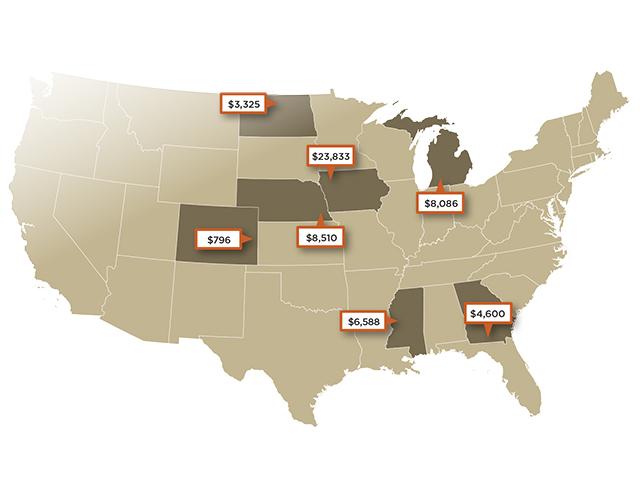DTN Before The Bell Grains
U.S. Soybean Council Verifies China Soybean Purchases
Morning CME Globex Update:
Outside markets are stable this morning with Dow futures hovering around unchanged to down 3 points. January crude oil is down 55 cents and approaching $50 again, the U.S. dollar index is up .2010, and February gold is down $3.70. China has also reportedly told state oil trader Unipec to buy U.S. crude oil, and it is expected that they will cut auto tariffs.
Other Markets:
| Dow Jones: | Lower |
| U.S. Dollar Index: | Higher |
| Gold: | Lower |
| Crude Oil: | Lower |
P[L1] D[0x0] M[300x250] OOP[F] ADUNIT[] T[]
Corn:
March corn, although firm, could not hold early gains on Wednesday, possibly due to disappointment over the reported 500,000 metric tons (mt) soybean sales to China announced on some newswires, and the lack of feed grain purchases. However, export sales out today were expected to show a large number, with estimates of 1 to 1.5 million metric tons (mmt) but came out at 903,000 mt or 35.6 million bushels (mb). Total commitments are now up 16% versus last year. China's statement that it will improve access to their markets to foreign companies is surely a positive. Ethanol production was off 2.2% week on week, and stocks fell by a modest 0.6%. Corn futures did hit the highest level that we've seen in many months. The $3.90 area on March will likely be resistance, with the gap at $3.80 still the support. The corn market is approaching overbought levels. There are a few weather issues in South America to watch, with heavy rains and flooding in parts of Argentina, and a dry pattern in central Brazil. The trade will be closely monitoring that. December futures expire on Friday at noon, and have just 1,000 contracts open coming in. DTN's National Corn Index closed at $3.49 on Wednesday, with an average basis of 36 centsunder March.
Soybeans:
January soybeans are down despite several reputable news outlets talking of China soybean purchases amounting to up to 2.4 mmt. The strength of the past few days may have been exporters covering sales, and/or China protecting themselves ahead of sales announcements. Perhaps the most notable outlet confirming China soy purchases was the U.S. Soybean Council suggesting that 1.5 to 2 mmt were done in a Bloomberg article. There are other sources which suggest that a string of additional sales are likely to show up over the coming days and weeks. The trade talk for the last few days has been more on the order of 5 to 8 mmt. Early Thursday, USDA said 41.5 million bushels (1,130,000 mt) of U.S. soybeans were sold to China for 2018-19. Export sales on soybeans came out at 792,000 mt, or 29.1 mb, with total commitments now 34% under last year. The trade will be watching two weather issues - growing dryness in parts of Brazil, which extends to late December, and heavy rains and flooding in Argentina, with some areas looking at up to 20" of rain the next two weeks. January beans nearly reached their summer high yesterday before retreating, and a rally and close above that $9.32 3/4 level would point to a move toward $9.50-$9.60, but surely this is a rally in a bear market and should be rewarded with sales. January soybeans DTN's National Soybean Index closed at $8.33, and reflects an average basis of 87 cents under January.
Wheat:
Wheat futures were the star of the day on Wednesday, and surprisingly it was downtrodden Kansas City futures leading the way higher, up sharply again today. There are a few issues that bear watching: heavy rains in Argentina, where some 50-55% of the wheat harvest is yet to come, and flooding in some areas is likely to cause quantity and quality issues. Likewise in Australia, where production was lowered another 500,000 mt by the USDA to 17 mmt (private sources see that crop closer to 15 mmt), there is now heavy rain that could impact quality there also, and low protein talk is widespread. European wheat futures hit the highest level in 8 weeks on Wednesday. Egypt's GASC bought 180,000 mt of wheat for early February, from Russia and Romania, with one HRW cargo offered, but some $30 per ton on a landed basis too high, and there was no U.S. SRW offered. There is also talk that, although USDA just raised Russian wheat exports by 1.5 mmt to 36.5 mmt, that Russian wheat prices have been moving higher, and there is talk that the ag minister could impose export restrictions. Export sales on U.S. wheat last week were 754,000 mt, or 27.7 mb, and are now down 14% year on year. The HRW wheat basis, which has been very strong, did fall 5-10 yesterday cents with futures strength. Some technical traders say that a KC March close above $5.13 could send this market up to the $5.30-$5.35 area. DTN's National HRW index closed at $4.80, and the average basis is at 31 cents under March.
Dana Mantini can be reached at dana.mantini@dtn.com
Follow Dana on Twitter @mantini_R
(KR)
Copyright 2018 DTN/The Progressive Farmer. All rights reserved.



